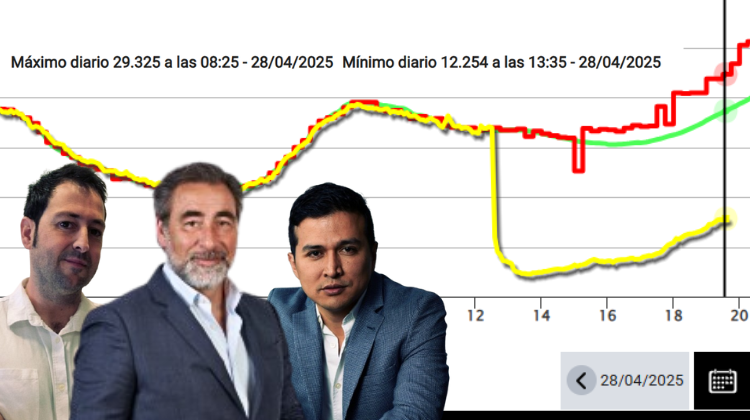On 28 April 2025, Spain, Portugal, and parts of southern France suffered one of the most severe blackouts in recent history.
At 12:32 pm (peninsular time), a “total loss of voltage” disconnected the Iberian Peninsula from the European electricity system, leaving millions without power and paralysing essential services.
At 1:30 p.m., the data system of Red Eléctrica de España (REE) recorded a demand of 10,480 MW, the lowest point of the blackout. Throughout the day, it was confirmed that full recovery would take between six and ten hours, although in Portugal it was warned that normalisation could take up to a week.
By 5:00 a.m., 92% of the mainland demand had been restored, reaching 20,757 MW, and it was announced that 100% of the substations in the transmission network had been energised.


The event highlighted the structural vulnerabilities of the Iberian electricity system: limited interconnection capacity with Europe, high dependence on low-inertia renewable sources, and the complexity of managing a system amid an energy transition.
The causes of the blackout remain under investigation. Although a cyberattack was mentioned as a possibility, both the Portuguese National Cybersecurity Centre and European authorities dismissed concrete evidence. The most plausible hypothesis points to a fault in a high-voltage line, possibly affected by a wildfire in southern France, combined with limited interconnection and high renewable penetration.
Spain’s Ministry of the Interior declared a state of emergency in several autonomous communities, while the European Commission, together with ENTSO-E, is coordinating efforts to determine the origin of the collapse.
Meanwhile, operators such as REE, REN, and RTE activated crisis protocols, forming “electrical islands” and using interconnections with France and Morocco to accelerate supply restoration.
Electrical interconnections: A key factor
For years, the Iberian Peninsula has called for greater integration with the European electricity grid. Pedro Amaral Jorge, CEO of APREN, argues that “it is necessary to increase renewable capacity in Europe in line with the NECP 2030, reinforce redundancy, and expand grid capacity.”
In conversation with Strategic Energy Europe, the executive emphasises that improving interconnections would lower the cost of electricity projects and reduce risks, while also allowing for “balancing the electricity system with power generation from other EU countries.”
Currently, Spain’s interconnection capacity with Europe stands at just 3-5% of its installed capacity, well below the 10% target set by the European Union. This limitation prevented sufficient energy imports to stabilise the grid after the severe oscillation that triggered the blackout.
Echoing reports from Portugal, Carlos Martín Graña, COO of ENERJOIN, suggests that a possible cause was the collapse of the interconnection with France due to wildfires in the Pyrenees region. “When the interconnection is lost, a major power fluctuation occurs, which can cause the frequency to drop. If balance is not restored in time, a blackout happens automatically,” he explains.
The executive notes that recovery is particularly challenging because Spain operates a large and relatively isolated energy system, complicating swift restoration.
Renewables at the centre of the debate
Although renewable energy is a cornerstone of the energy transition, the event reignited discussions about its impact on system stability. At 12:30 pm on the day of the blackout, 60% of Spain’s electricity came from solar generation, according to Bloomberg.
Analysts and the Ministry for the Ecological Transition warned that low-inertia renewable sources, such as solar and wind, can amplify oscillations if not properly managed.
For Martín Graña, renewables were not the direct cause, but he acknowledges that “the issue of reactive power from renewables doesn’t help either.” The COO of ENERJOIN describes the blackout as a cascade of factors, where the lack of thermal generation at that time reduced system inertia.
Meanwhile, Wilson Acosta Pinzón, a Business Developer specialised in energy transition, agrees that such events require “very significant multiple failures” to disconnect the entire peninsula. The specialist highlights that Spain, a leader in solar and wind energy, must restart its system from domestic power plants, carefully managing load synchronisation.
Acosta Pinzón stresses the importance of hydraulic, thermal, and nuclear sources to support the grid during critical moments. “It is essential for Spain to reconnect to the European system; otherwise, synchronising the entire grid independently will be chaotic,” he warns.
Lessons for the energy transition
The 28 April blackout underscored the urgent need to modernise electrical infrastructure, increase interconnection capacity, and improve the management of systems with high renewable penetration.
Pedro Amaral Jorge insists that it is crucial to “increase investment in energy management and electricity system administration.”
In the meantime, the Iberian system faces the challenge of balancing its leadership in clean energy with ensuring security and supply stability.
The energy transition is progressing, but events like this serve as a reminder that decarbonisation must be accompanied by resilient infrastructure and coordinated efforts at the European level.







